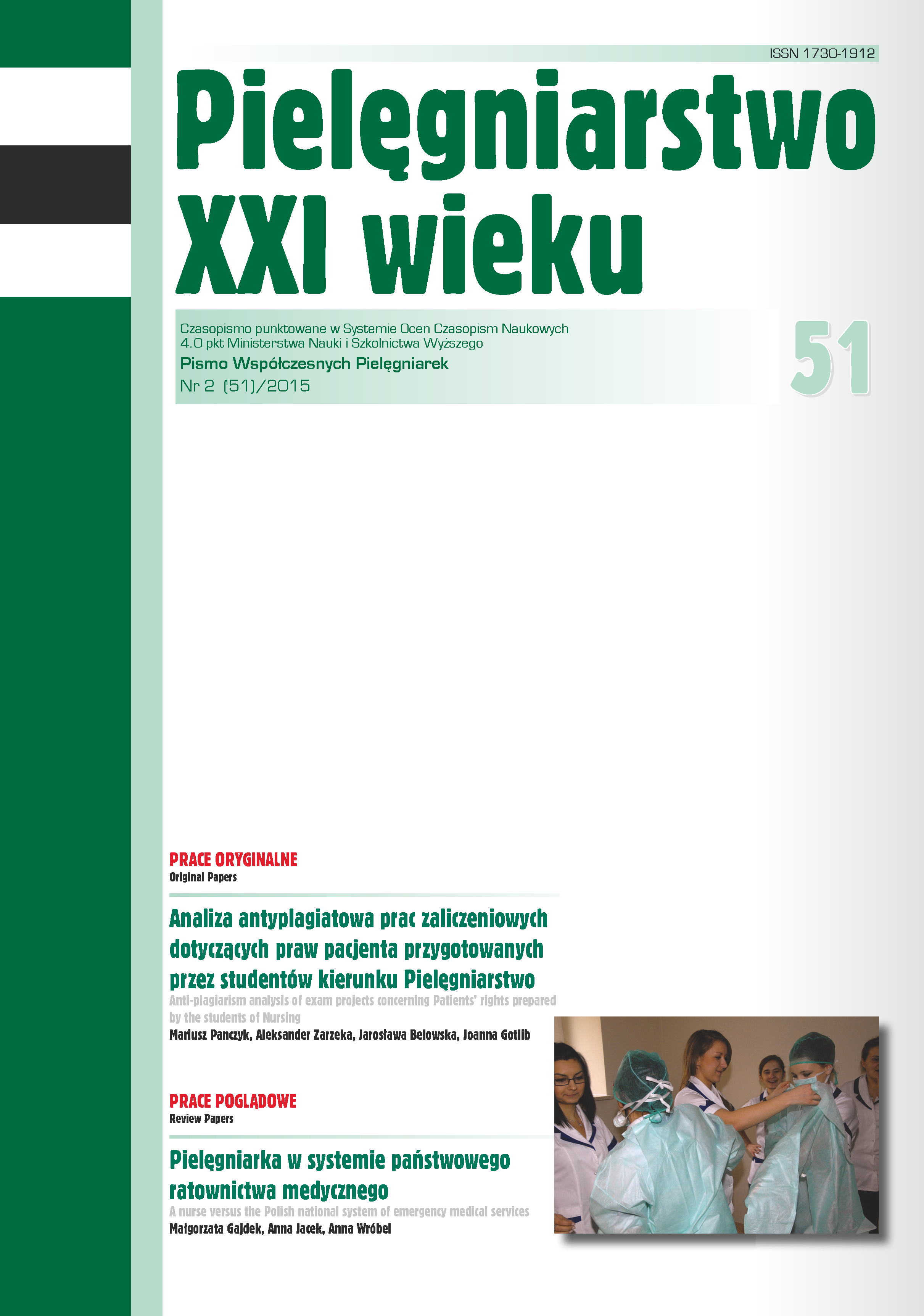The analysis of bacteriological examination of bronchial washings in patients with respiratory track diseases with special respect to obstructive pulmonary diseases
DOI:
https://doi.org/10.12923/p21w-2015-2/18Keywords:
respiratory tract infection, drug-resistant bacteria, bronchial washingAbstract
THE ANALYSIS OF BACTERIOLOGICAL EXAMINATION OF BRONCHIAL WASHINGS IN PATIENTS WITH RESPIRATORY TRACK DISEASES WITH SPECIAL RESPECT TO OBSTRUCTIVE PULMONARY DISEASES
Introduction. Infections of the lower respiratory airways track are one of the leading causes of morbidity and mortality all around the world. They exert huge influence over both the development and course of pulmonary diseases and also often lead to an exacerbation of obstructive lung diseases.
Aim. The analysis of bacteriological examinations and changes in microbiological profile in bronchial washings.
Material and methods. A retrospective analysis of microbiological examinations of bronchial washings was performed on 1658 patients (777 in 2011 and 881 in 2013). The analysis included 153 COPD and 128 asthmatic patients. Bronchial washings were obtained after instilling isotonic saline in 2011 and Ringer‘s solution in 2013.
Results. Bacteriological examinations of bronchial washing usually revealed a normal bacterial flora (51.87%). In COPD patients, the most often isolated pathogens were Staphylococcus aureus (14.38%) and Pseudomonas aeruginosa (13.73%). In asthmatic patients during exacerbations the most common pathogens were Staphylococcus aureus (15.63%) and Klebsiella pneumoniae (7.81%). The presence of drug-resistant strains was detected in 162 cases (9.77%). The following ones were found most frequently: Staphylococcus aureus MRSA – methicyllin-resistant Staphylococcus aureus, Klebsiella pneumoniae ESBL – extended-spectrum ?-lactamases (+) and Pseudomonas aeruginosa. A statistically significant difference was found in case of Proteus mirabilis, with the incidence rate of 22 cases in 2013 and merely 10 cases in 2011 (2.83% vs 1.14% respectively; p=0.01), which may suggest protective role of NaCl used for collecting of bronchial washing.
Conclusions. Microbiological examinations of bronchial washings make it possible to identify pathogens responsible for infections of the lower respiratory tract.
References
1. Hilty M, Burke C, Pedro H. i wsp. Disordered microbial communities in asthmatic airways. PLoS One. 2010; 5(1): 1-9.
2. Sethi S, Murphy T. Bacterial Infection in Chronic Obstructive Pulmonary Disease in 2000: a State-of-the-Art Review. Clin. Microbiol. Rev. 2001;14: 336-363.
3. Sethi S. Bacteria in Exacerbations of Chronic Obstructive Pulmonary Disease. Ann. Am. Thorac. Soc. 2004; 1: 109-114.
4. Demkov U. Diagnostyka immunologiczna i molekularna zakażeń dróg oddechowych. Pneumonol. Alergol. Pol. 2011;79:446-453.
5. Charles PG. Early diagnosis of lower respiratory tract infections (point-of-care tests). Curr. Opin, Pulm. Med. 2008;14(3):176-182.
6. Heczko PB, Wójkowska-Mach J. red. Zakażenia szpitalne. Warszawa: Wyd. Lekarskie PZWL; 2009.
7. Szewczyk E. red. Diagnostyka mikrobiologiczna. Warszawa: Wyd. Nauk. PWN; 2005.
8. Du Rand I, Barber P, Goldring J i wsp. British Thoracic Society guideline for advanced diagnostic and therapeutic flexible bronchoscopy in adults. Torax 2011; 66(3):1-24.
9. Howard L, Sillis L, Pasteur M.: Microbiological profile of community-acquired pneumonia in adults over the last 20 years. J. Infection 2005; 50 (2):107-113.
10. Polverino E, Dambrava P, Cilloniz C i wsp. Nursing home-acquired pneumonia: a 10 year: single-centre experience. Thorax 2010;65:354-359.
11. Zieliński M, Dworniczak S, Dworniczak A. i wsp.: Occurrence of alert pathogens in patients hospitalised in the department of lung diseases. Pneumonol. Alergol. Pol. 2015;83:101-108.
12. Webb B, Dascomb K, Stenehjem E. i wsp. Predicting risk of drug-resistant organisms in pneumonia: Moving beyond the HCAP model. Resp. Med. 2015; 109(1):1-10.
13. Noweta K, Frankowska M, Grzelewska-Rzymowska I. Zaostrzenia przewlekłej obturacyjnej choroby płuc z uwzględnieniem bakteriologicznego badania plwociny. Pneumonol. Alergol. Pol. 2006;74:396-402.
14. Górecka D, Jassem E, Pierzchała W, i wsp. Zalecenia Polskiego Towarzystwa Chorób Płuc dotyczące rozpoznawania i leczenia przewlekłej obturacyjnej choroby płuc (POChP). Pneumonol. Alergol. Pol. 2012;80(3):220-254.
15. Albertson T, Louie S, Chan A. Rozpoznawanie i leczenie zaostrzeń przewlekłej obturacyjnej choroby płuc i przewlekłego zapalenia oskrzeli u chorych w podeszłym wieku. Medycyna Wieku Podeszłego 2011;1(1):1-14.
16. Global strategy for the diagnosis, management, and prevention of chronic obstructive pulmonary disease. Global Initiative for Chronic Obstructive Pulmonary Disease, June 2014. Available from: http://www.goldcopd.org/uploads/users/files/ GOLD_Report_2014_Jun11.pdf
17. Kozielski J. Postępowanie w zaostrzeniach bakteryjnych chorób obturacyjnych. Pol. Merk. Lek. 2011; 31, 184: 201-203.
18. Specjalski K.: Rola zakażeń Chlamydia pneumoniae i Mycoplasma pneumoniae w przebiegu astmy. Pneumonol. Alergol. Pol. 2010; 78(4): 284-295.
Downloads
Published
Issue
Section
License
Copyright (c) 2024 Anna Andrychiewicz, Anita Borowiecka, Jerzy Soja, Krzysztof Sładek (Autor)

This work is licensed under a Creative Commons Attribution 4.0 International License.




